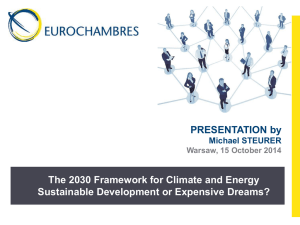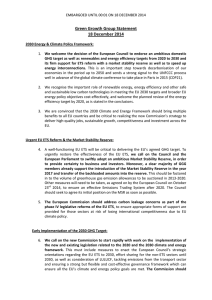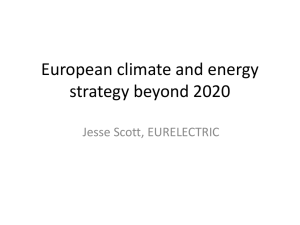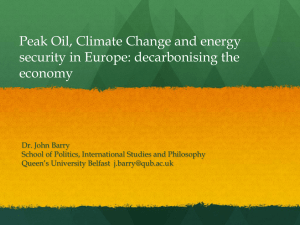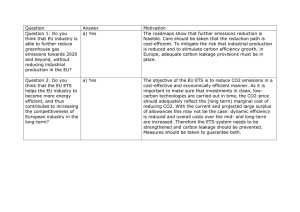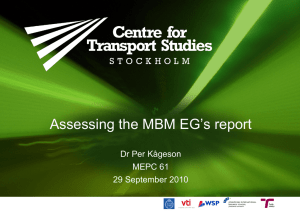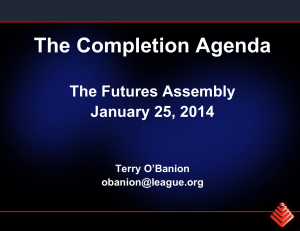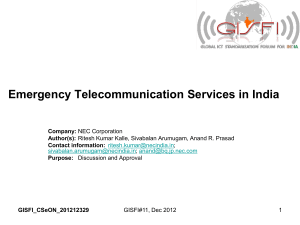- rksi.org
advertisement
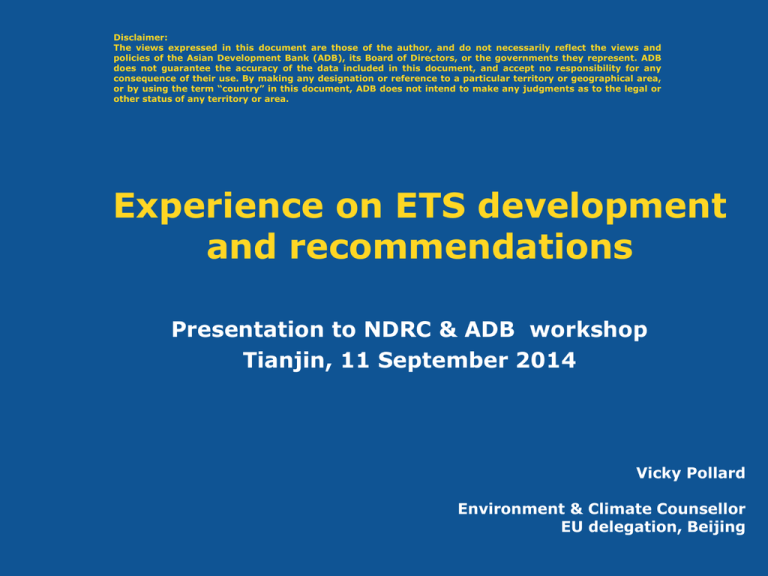
Disclaimer: The views expressed in this document are those of the author, and do not necessarily reflect the views and policies of the Asian Development Bank (ADB), its Board of Directors, or the governments they represent. ADB does not guarantee the accuracy of the data included in this document, and accept no responsibility for any consequence of their use. By making any designation or reference to a particular territory or geographical area, or by using the term “country” in this document, ADB does not intend to make any judgments as to the legal or other status of any territory or area. Experience on ETS development and recommendations Presentation to NDRC & ADB workshop Tianjin, 11 September 2014 Vicky Pollard Environment & Climate Counsellor EU delegation, Beijing Overview Recent Developments in the EU ETS Supply Issues How these are being addressed & lessons learned Next steps: Revision of the EU ETS & preparing for 2030 2 Carbon pricing and European carbon market €/t Mt 35 120000 30 100000 25 80000 20 5 0 Jan 08 Jan 09 Jan 10 Jan 11 Jan 12 Source: Bloomberg New Energy Finance Jan 13 •Created EU-wide price signal 60000 •Covers some 11000 installations 40000 •Liquid market with growing volumes 20000 •But issues of oversupply that depress the price 15 10 EU Emissions Trading System since 2005: 0 Jan 14 Substantially improved architecture as of phase 3 (agreed 2008, starting in 2013) The EU ETS is working well from a technical point of view Starting last year, it saw a major overhaul Cap-setting is an EU process Auctions are a daily routine Harmonised free allocation to industry and carbon leakage provisions Single registry is operational Rules for recognising international credits Improved protection against fraud (allowances covered by new MiFID) Use of ETS revenue to fund clean energy project across the EU, including carbon capture and storage (€2.2 billion for projects in 20 Member States) Starting point: 2084 Mt in 2013 Declining EU-wide cap beyond 2020 Gradient: -1.74% 2199 Mt/yr 1816 Mt -21% 2010 2011 2012 2013 2014 2015 2016 2017 2018 2019 2020 2021 2022 2023 2024 Nota bene: The figures include the EEA EFTA States Auctions are daily routine • Transition has taken place in 2013 to large-scale auctioning • As from 2013 more than 50% of allowances (only 4% in phase 2) are auctioned and this share is to increase • For the entire 3rd phase (2013-2020) almost 7.5 billion allowances are to be auctioned • Auction revenues belong to the Member States • At least 50% of auction revenue should be used to tackle climate change and adapt to effects e.g. in DE, all auction revenue used for Climate and Energy Fund Revised rules for recognising international credits 2nd period: Quantity determined in NAPs => ranging from 7% to 20.6% of NAP allocations with most MS allowing 10% Few qualitative restrictions: no credits from nuclear and LULUCF, only certain hydro projects 3rd period Quantity: Overall use of credits restricted to 50% of reduction effort 2005 to 2020 Only small additional volumes on top of what is allowed already Quality: More selective recognition of international credits Large inflow of international credits has contributed to oversupply; proposal for post 2020 require more domestic action, less use of international credits The carbon market today • The carbon market is working well from a technical point of view • price formation based on fundamentals, liquid market, delivering emission reductions • Large and persistent market imbalance (surplus >2 bn) • Back-loading of auction volumes only first, temporary step Rapid accumulation of the surplus Back-loading Persistent surplus Structural reform of the EU ETS Serves a dual purpose: •Tackle existing surplus • If not addressed, the imbalance would profoundly affect ability to meet the medium-term target in a cost-effective manner •Make the EU ETS more resilient to large demand shocks in the near and distant future The policy response: Create a market stability reserve Market stability reserve: Operation Allowances in circulation [mio] When above the range, allowances added to the reserve Range When below the range or art. 29a, allowances released from the reserve Time Annual publication of total number of allowances in circulation – starting May 2017 Market stability reserve: Architecture • Introduction at the start of phase 4 of the EU ETS in 2021 • To provide regulatory certainty during phase 3 and give market participants lead-time before the rule changes applies • The reserve is rule-based – no leeway for discretion in implementation • No need for new institutions or new data – fully embedded in existing framework • Captures all changes in demand, including due to interaction with complementary policies • Due to its automatic nature early review of key parameters in 2026 • At the end of each trading period, allowances held in the reserve are carried forward • Does not affect free allocation to industry Other ETS related elements of the 2030 framework: Linear reduction factor determining the cap Current linear reduction factor of 1.74% Proposed 40% greenhouse gas emissions reduction target Linear reduction factor of 2.2% •Not part of the legal proposal for the reserve •Insufficient to reduce the imbalance in the mid-term Other ETS related elements of 2030 framework: Containing the risk of carbon leakage Stable framework for this decade Carbon leakage list (for 2015 to 2019) with the current criteria and assumptions Continued but more focused free allocation after 2020, complemented with innovation support Consultation on how best to take into account the competitiveness concerns of industry Next steps • Market Stability reserve: • European Parliament: 1st exchange of views in ENVI Committee in March & work will start again after elections this autumn • Council: Environment Working Party has been working on the subject • Climate and Energy Package for 2030: heads of State and Government of 28 Member States to agree in October on main goals • Legislative proposals will follow including for ETS Phase 4 Thank you For the EU ETS regulatory updates subscribe to: http://ec.europa.eu/clima/rss/news_regulatory_en.xml Harmonised free allocation and carbon leakage rules • Industrial sectors receive free allocation based on product benchmarks • Basic principle: ‘one benchmark – one product’ • no distinction in allocation depending on fuel, technology, raw material etc. • Benchmarks set at GHG performance of the 10% best installations throughout the EU producing that product • 52 product benchmarks covering 75% of the industrial emissions and 3 ‘fall back approaches’ were determined • Sectors exposed to risk of “carbon leakage” receive free allocation at 100% of benchmark level • • Carbon leakage list records sectors meeting criteria is renewed in 5-year intervals 176 sectors and sub-sectors are currently listed • Free allocation and carbon leakage rules have proven to be an effective safeguard for EU industry Single registry is operational 1st and 2nd period: national registries, CITL to mirror transactions 3rd period: Community-wide, single registry at EU level Keeps track of all emissions from ETS (and as from 2013 also non-ETS sectors) • • • • • 30.000 users and more than 15,000 accounts migrated from national reg. System hosted at Commission and implemented with high performance and security requirements New security measures (strengthened Know-Your-Customer, 2-Factor authentication, transaction delays, business hours) Consolidation of the Kyoto Protocol registries and connection to the UNFCCC transaction log New Service desk to support National Administrators Member States remain responsible for users and accounts


